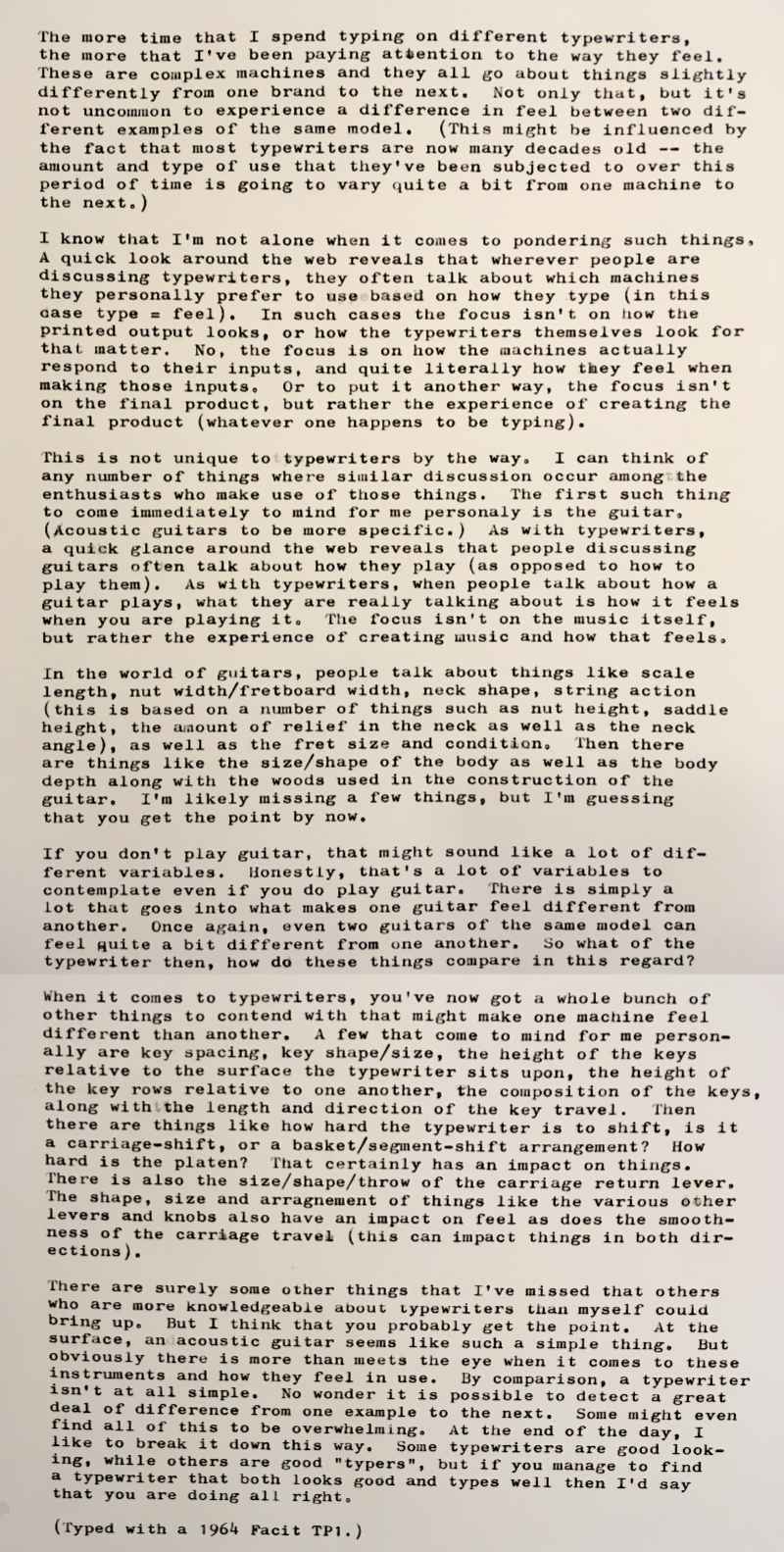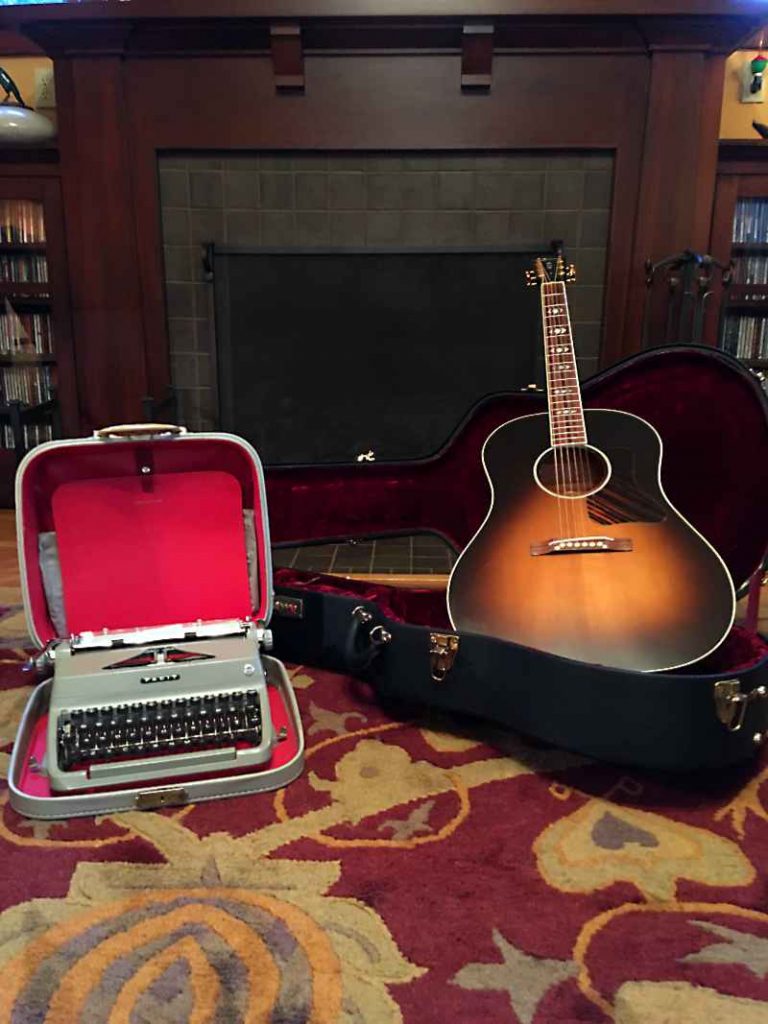
The more time that I spend typing on different typewriters, the more that I’ve been paying attention to the way they feel. These are complex machines and they all go about things slightly differently from one brand to the next. Not only that, but it’s not uncommon to experience a difference in feel between two different examples of the same model. (This might be influenced by the fact that most typewriters are now many decades old — the amount and type of use that they’ve been subjected to over this period of time is going to vary quite a bit from one machine to the next.)
I know that I’m not alone when it comes to pondering such things. A quick look around the web reveals that wherever people are discussing typewriters, they often talk about which machines they personally prefer to use based on how they type (in this case type = feel). In such cases the focus isn’t on how the printed output looks, or how the typewriters themselves look for that matter. No, the focus on how the machines actually respond to their inputs, and quite literally how they feel when making those inputs. Or to put it another way, the focus isn’t on the final product, but rather the experience of creating the final product (whatever one happens to be typing).
This is not unique to typewriters by the way. I can think of any number of things where similar discussions occur among the enthusiasts who make use of those things. The first such thing to come immediately to mind for me personally is the guitar. (Acoustic guitars to be more specific.) As with typewriters, a quick glance around the web reveals that people discussing guitars often talk about how the play (as oppose to how to play them). As with typewriters, when people talk about how a guitar plays, what they are really talking about is how it feels when you are playing it. The focus isn’t on the music itself, but rather the experience of creating music and how that feels.
In the world of guitars people talk about things like scale length, nut width/fretboard width, neck shape, string spacing, string action (this is based on a number of things such as nut height, saddle height, the amount of relief in the neck as well as the neck angle), as well as the fret size and condition. Then there are things like the size/shape of the body as well as the body depth along with the woods used in the construction of the guitar. I’m likely missing a few things, but I’m guessing that you get the point by now.
If you don’t play the guitar, that might sound like a lot of different variables. Honestly, that’s a lot of variables to contemplate even if you do play guitar. There is simply a lot that goes into what makes one guitar feel different from another. Once again, even two guitars of the same model can feel quite a bit different from one another. So what of the typewriter then, how do things compare in this regard?
When it comes to typewriters, you’ve now got a whole bunch of other things to contend with that might make one machine feel different than another. A few that come to mind are key spacing, key shape/size, the height of the keys relative to the surface the typewriter sits upon, the height of the key rows relative to on another, the composition of the keys, along with the length and direction of the key travel. Then there are things like how hard the typewriter is to shift, is it a carriage-shift, or a basket/segment-shift arrangement? How hard is the platen? That certainly has an impact on things. There is also the size/shape/throw of the carriage return lever. The shape, size and arrangement of things like the various other levers and knobs also have an impact on feel as does the smoothness of the carriage travel (this can impact things in both directions).
There are surely some other things that I’ve missed that others who are more knowledgeable about typewriters than myself could bring up. But I think that you probably get the point. At the surface, and acoustic guitar seems like such a simple thing. But obviously there is more than meets the eye when it comes to these instruments and how they feel in use. By comparison, a typewriter isn’t at all simple. No wonder it is possible to detect a great deal of difference from one example to the next. Some might even find all of this overwhelming. At the end of the day, I like to break it down this way. Some typewriters are good looking, while others are good “typers”, but if you manage to find a typewriter that both looks good and types well, then I’d say that you are doing all right.
(Typed with a Facit TP1)
AFTERTHOUGHTS: One very obvious key thing that I left out when it comes to the feel of a typewriter is the relative ease, or stiffness of the key action. This would be the aspect of a typewriter that most aligns with the action (or string action) of a guitar. While a guitar requires a string change at a minimum to impact the action , many typewriters have a built-in tension control to adjust the amount of pressure it takes to complete a key strike. The other point that I should have made above it that as with so many other things, when it comes to both typewriters and guitars, one’s personal preferences play a very large part in why some examples feel better to us than others, yet we might not all agree as to which examples feel the best. Understanding your own preferences is key (no pun intended) to finding the ultimate in typing happiness.


One difference between a manual typewriter and an acoustic guitar is that (at least in the case of steel-stringed guitars) playing an acoustic guitar comes with a certain amount of pain. As a newbie, self-taught guitarist, I had trouble finding a guitar that didn’t simply hurt too much to play after 30 minutes or so. Of course, a certain amount of toughening up comes with the territory, and I suppose all those apocryphal stories about guitar heroes playing until their fingers bled were supposed to reinforce the lesson. Still, on the very few occasions I was able to handle a fine (i.e., expensive and well-crafted) guitar, I noticed how much easier it was to press a string against the fret enough to get a clear tone.
In my more recent experience with typewriters, I find that not only that different models have their own signature feel, and that (as you mention) different examples of the same model typically come to differ due to the vagaries of age and use, but that the adjustments that used to be available no longer work as they should. It’s rare to find a typewriter whose built-in touch adjustment makes much of a difference, and I’m fairly sure that they once did. I think we shouldn’t underestimate the change age has made in even fully functioning vintage typewriters. I once watched a 1950s instructional video on speed typing using Smith-Corona 88 office typewriters. I could see that the demonstrator was typing with no more than minimal finger pressure, and that when he hit the carriage lever, the carriage glided like the puck on an air hockey table. In contrast, I had my 88 serviced by a guy who’s been repairing typewriters his entire life, having inherited his typewriter shop from his father. But its action remains clunky and heavy.
Good points John. I would note that there are a number of people who choose to type using the hunt ‘n peck method simply because touch typing was too painful/difficult, especially when it came to using their pinkie fingers with manual typewriters (sort of like people giving up on barre chords with the guitar). It’s interesting but thus far I’ve been able to detect the difference made by the touch selector mechanism on all of the typewriters that I’ve purchased to date. That might have something to do with the fact that al of the typewriters I’ve bought have been in decent condition and likely weren’t used all that much (relatively speaking) prior to my ownership. In the end, there’s no telling just how much impact life to date has had on each individual typewriter by now, but I have no doubt that there are sure to be detectable differences in this regard from one example to the next.
Hello Again
I know that Guth is a member of Type-Talk and there is an interesting and quite in-depth discussion on how a typewriter feels in the thread Key Action vs Key Touch, read (https://typewriter.boardhost.com/viewtopic.php?id=3067) and see if your brain hurts after reading the whole thread. I’ve been riding and working on motorcycles since 1977 and it’s interesting how even two motorcycles of the same make, model and year can feel quite different simply because of the way they have been ridden by their owners.
The same goes for typewriters, although two identical machines may have come off the assembly line on the same day some 70 years ago, they might feel quite different today simply due to the amount of use they’ve had over the years. All the best,
William
Oh boy, I took at glance at that thread and realized that it’s going to take some time to really digest it all. Even though I haven’t read the thread in it’s entirety, it seemed to me that the very first response by “skywatcher” seemingly got to the heart of the matter, and subsequent posts introduced a number of factors that do impact the feel of a typewriter, but aren’t necessarily related to either key action or key touch. I’ll have to dig into that thread a bit more later on.